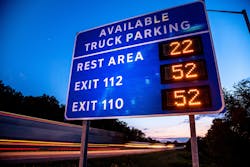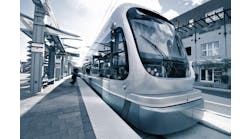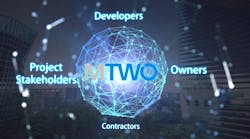The relationship between drivers, our vehicles and the road is evolving, with the rate of evolution accelerating at a pace that was almost unimaginable 50 years ago. This is especially true for transportation infrastructure such as road signs, traffic signals, electronic speed-limit signs and other traffic-control devices.
In years past, the interface between cars and the road consisted of four patches of rubber on the asphalt and one pair of eyes monitoring conditions. Traffic-control systems operated based on data generated at a specific point, and if signal timings changed, rarely was the change based on more than time of day or volume thresholds. Dynamic message signs, both portable and permanent, were limited to displaying rudimentary information like “construction zone ahead,” safety messages like “click it or ticket” and high-level emergency contact information.
Now, new data sources have begun to enhance the ability of these systems. For example, today we can deliver more up-to-the-minute information by using probe data. Probe data utilizes location-based information—like the GPS on your cell phone—to predict how long it will take drivers to get from Point A to Point B based on current conditions and other drivers’ experiences on the same route.
Tomorrow’s infrastructure will be enhanced by a broadening depth of data sources and data types, while not being limited based on where and how the data is collected. Vehicles will have 360° awareness of their surroundings and will communicate with other vehicles 10 times per second. At the same time, roads will be sharing real-time information with vehicles about their current conditions, enabling a whole new set of applications and traffic management techniques.
Predictive traffic signs are the future of intelligent infrastructure.
What’s driving the evolution?
Our roadways need to become safer and more efficient because they are being used more and more. According to the Office of Highway Policy Information, there were 210 million licensed drivers in the U.S. in 2009, and that number continues to grow every year. The National Highway Traffic Safety Administration (NHTSA) Fatal Analysis Reporting System (FARS) reports that in 2014, 32,675 people died in motor-vehicle crashes with a fatality rate of 1.07 deaths per 100 million vehicle miles traveled, and those numbers, tragically, are on the rise. The Texas A&M Transportation Institute and INRIX yearly Urban Mobility Scorecard shows the nation’s congestion problem increased in 2015, with travel delays totaling 6.9 billion hours, 3.1 billion gal of fuel wasted and overall congestion costs of $160 billion.
Our goal as operators of the transportation system closely mirrors the goals we all have when we start on a journey, regardless of mode—arrive safe and on time. A more efficient traffic system means drivers will get to their destinations faster and delays overall will be reduced, resulting in fewer crashes. There also are environmental effects to consider. When thousands of cars and trucks are stuck in traffic, they are belching out emissions and wasting fuel.
One of the safety challenges we face is the need to either reduce or eliminate driver distractions in the vehicle or work to build a transportation system that embraces those distractions. For many drivers of all generations, actually driving the car has become the distraction, while their attention is focused more on engaging in social media, eating a meal or taking care of kids in the back seat.
Since we will never be able to get cell phones or hamburgers out of people’s hands, we need to find ways to make driving less reliant on the driver’s ability to perceive and react. We are already seeing automakers indirectly addressing this challenge with cars that can brake on their own or correct themselves if they are swerving into another lane. As these technologies progress, ultimately driverless cars will become the norm—but until then, we must continue to make the roads safer for all drivers, distracted or otherwise.
From static to dynamic to predictive
In the near future, during this transition period to fully self-driving cars, traffic infrastructure will add a significant level of predictiveness to information already provided. As drivers, we will soon know not just what has happened and what is happening, but also what could or will happen, literally “down the road.”
For example: You are driving from Point A to B on a Thursday afternoon at 2 p.m., and there is a crew patching the road 5 miles ahead. Predictive data will look at the current traffic flow, the traffic flow from the past four Thursdays at 2 p.m. and the traffic patterns from the last three times patching crews were on that road. The result for you as a driver is a highly informed, intelligent prediction of how traffic will flow, along with an accurate estimate of your travel time. We will even be able to proactively provide alternate routes so drivers can avoid trouble spots, and those alternate routes will be selected using the same predictive traffic models.
Traffic signals operating with a much richer data source will be able to execute more predictive traffic signal timing based on platoons that are coming down the road, or weather that is causing traffic to slow down. The signal will make decisions as vehicles approach, using a more robust set of data than is currently available from traffic-detection devices, and adjust their timing plan based on other nearby signals and the arrival vectors for all oncoming traffic. They will have a significantly enhanced ability to keep traffic moving efficiently.
A more intelligent traffic system also will have a significant impact on the freight industry. Many commercial truck drivers travel hundreds of miles to make deliveries, and improving efficiencies can reduce greenhouse emissions and operating costs.
We are already seeing the pieces of this being put in place with smarter weigh stations and better permitting processes that reduce the amount of time drivers have to stop en-route. There has been significant interest in smart truck parking systems, which inform truckers what parking spots and rest areas are available ahead for them to take their mandatory rest, reducing the time they spend driving looking for a safe parking spot. Truck Smart Parking Services, a partner working with the Federal Motor Carrier Safety Administration (FMCSA) to develop a national “SmartPark” system, estimates that by reducing the amount of time spent searching for a spot to rest by as little as 15 minutes, the trucking industry could save $4.4 billion each year.
Improving our freight systems will have a huge impact on manufacturing and other industries that rely on freight and just-in-time delivery practices. Right now, if there is a crash on the highway, delivery systems can be significantly delayed, which can throw off production levels for manufacturing plants. Predictive travel information will be critical for keeping this vital industry on its course.
Traffic management centers contribute to predictive travel information.
What needs to happen
The exciting news is that many of these technologies and concepts are currently being developed, tested and deployed. Our job in the transportation industry is to be open to testing and deploying these new concepts. For example, HNTB is currently working on the connected vehicle program with U.S. DOT as well as many state and local agencies and car manufacturers to get cars to broadcast safety information to improve safety operations. One of the primary pilot sites is in Tampa, Fla., and will include passenger cars, buses and trolleys, as well as pedestrians and infrastructure-based systems. Likewise, HNTB is working with the city of Columbus, Ohio, to deploy a system throughout the city, using the same basic technologies to enhance operations of the new C-MAX BRT.
Intelligent infrastructure will require the ability to collect, store and process significantly larger amounts of data than the transportation industry is used to working with today. Our ability to operate our transportation system will continually evolve, because we will continue to have more and better data available. Every time we think we have it figured out in terms of data, a new resource will come along to provide new and better information. Yesterday our freeway systems had traffic detectors at regularly spaced intervals. Today, we are beginning to collect probe data on speed and location of vehicles. Tomorrow, we will use windshield wiper status to inform predictive weather applications. Beyond that, who knows?
The next generation of traffic and transit systems also will require new skills by those who operate and manage these systems. As an example, the automobile industry used to be dominated by mechanical engineers. Today, the car industry is facing a shortage of electrical engineers and computer programmers because every new car sold contains more lines of code than the space shuttle.
In the past, transportation engineering has focused on civil engineering and planning. Transportation tomorrow will require application developers, software developers and other types of professionals who will be able to move the industry forward in response to the many changes in technology that are occurring daily all around us. This does not lessen the need for civil engineers and planners, but it means we need to look outside our traditional industry for these new skills.
Transit agencies also will need to keep one eye on technology changes and constantly evaluate their investment strategies to use these new technologies to improve the safety and efficiency of their transit systems. They also will need to continually evaluate labor contracts and operating policies to ensure these documents do not prevent them from moving forward.
And, of course, adequate funding will always be needed. As Corporate Average Fuel Economy (CAFE) standards increase and fuel consumption decreases, per-gallon gas tax revenues will decrease as well, which will strain already tight budgets and make new initiatives more difficult to undertake. Our industry will need to find new revenue models and partnerships to deploy and operate new technologies. We also will have to work hard to gain public acceptance for new technologies. We will have to address issues ranging from privacy and data ownership to being willing to get in a vehicle without a driver. These issues will take time and education to overcome.
In conclusion
As our infrastructure becomes increasingly intelligent, we probably will not see many visible, physical changes in the foreseeable future. Roads will still look and mostly operate the same, but on the back end there will be a revolution. The networks that operate ITS deployments will continue to advance and evolve. Our systems will become more powerful and flexible in order to process new data. Transit agencies and partners will rethink how we work with one another and the public in order to successfully bring new technologies to market.
The data we are generating from our cell phones, our vehicles and other devices have the capacity to significantly transform transportation like never before. As the technology to gather, process, store and utilize that data gets better and better, we will be able to develop better algorithms to optimize the capacity of our roadways.
As the Greek philosopher Heraclitus once said, “The only thing constant is change.”
Change can be challenging and disruptive to current paradigms, but it also can be exciting and motivating.
We are on the cusp of a revolution in transportation, driven by advances in connectivity and automation. That means engineering and operational concepts, performance measures, algorithms, the transportation workforce, design standards, traffic-control systems and policies will be transformed.
We are already seeing some of the amazing things that can be done—and we have only just scratched the surface.



